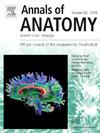人胎儿外生殖器海绵膜窦内皮的发育与生长。
IF 2
3区 医学
Q2 ANATOMY & MORPHOLOGY
引用次数: 0
摘要
背景:关于胎儿外生殖器海绵状窦内皮何时及如何发育的信息很少。方法:对37例胎龄8 ~ 40周的人胎儿(男25例,女12例)进行了勃起组织的组织学切片检查。结果:妊娠10 ~ 11周时,阴茎龟头和阴蒂窦腔充血;妊娠15 ~ 16周时,海绵体窦腔充血。在两性海绵体中,有血的窦状窦的开放明显延迟。阴茎海绵体内皮细胞与平滑肌肌动蛋白(SMA)抗体的交叉反应表明,内皮细胞的发育和生长始于尿道附近,并向更远的部位发展。在海绵体中,在20周或更晚的GA时,管腔的开口往往发生在中线间隔附近。25周后,窦腔融合,形成长或大的窦腔。同时,囊变厚,平滑肌丰富的中线鼻中隔有大量向前扩张的突出物。即使在晚期,间质组织中平滑肌也很少明显。相比之下,最初的雌性前庭球对应于14周时出现的sma阳性玫瑰状结构的带状簇。结论:血流引起的剪应力可能导致窦状管腔融合和内皮重建。本文章由计算机程序翻译,如有差异,请以英文原文为准。
Development and growth of cavernosal sinusoidal endothelia in the external genitalia of human fetuses
Background
There is little information about when and how cavernosal sinusoidal endothelia develop in the external genitalia of fetuses.
Methods
We examined histological sections of erectile tissue in 37 human fetuses (25 males and 12 females) whose gestational age (GA) ranged from 8 to 40 weeks.
Results
The sinusoidal lumen was filled with blood in the glans of the penis and clitoris at a GA of 10–11 weeks, and in the corpus spongiosum at a GA of 15–16 weeks. The opening of the sinusoids with blood was much delayed in the corpus cavernosum of both sexes. The cross-reactivity of the endothelia with smooth muscle actin (SMA) antibody in the corpus spongiosum penis suggested that the development and growth of endothelia started at a site near the urethra and advanced to more distant site. In the corpus cavernosum, the opening of the lumen tended to occur near the midline septum at a GA of 20 weeks or later. After a GA of 25 weeks, the sinusoidal lumen fused, leading to long or large sinusoids. Simultaneously, the capsule became thick and the smooth muscle-rich midline septum had abundant protrusions that expanded anteriorly. Smooth muscles were rarely evident in interstitial tissues, even at late-term. In contrast, the initial female vestibular bulb corresponded to a belt-like cluster of SMA-positive rosette-like structures that appeared at a GA of 14 weeks.
Conclusion
Fusion between sinusoidal lumens with reconstruction of endothelia may occur as a consequence of shearing stress due to blood flow.
求助全文
通过发布文献求助,成功后即可免费获取论文全文。
去求助
来源期刊

Annals of Anatomy-Anatomischer Anzeiger
医学-解剖学与形态学
CiteScore
4.40
自引率
22.70%
发文量
137
审稿时长
33 days
期刊介绍:
Annals of Anatomy publish peer reviewed original articles as well as brief review articles. The journal is open to original papers covering a link between anatomy and areas such as
•molecular biology,
•cell biology
•reproductive biology
•immunobiology
•developmental biology, neurobiology
•embryology as well as
•neuroanatomy
•neuroimmunology
•clinical anatomy
•comparative anatomy
•modern imaging techniques
•evolution, and especially also
•aging
 求助内容:
求助内容: 应助结果提醒方式:
应助结果提醒方式:


